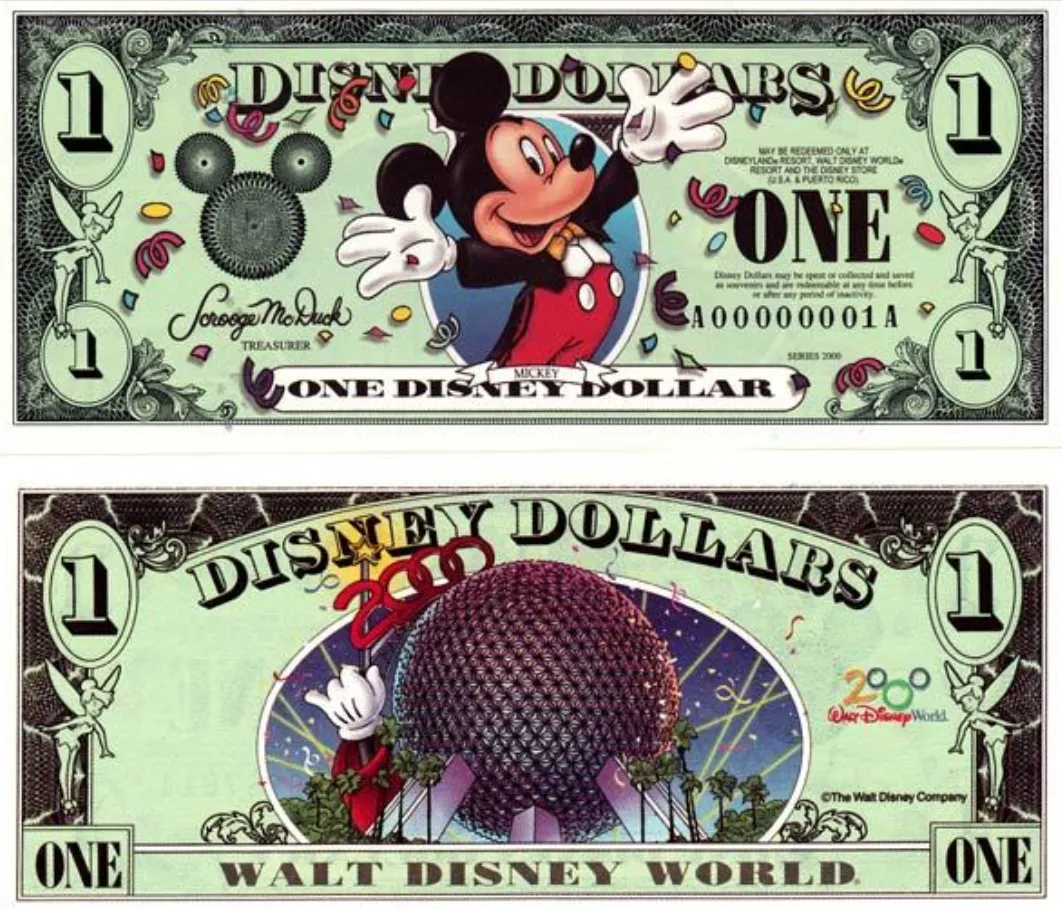
This is Part II of a series (since it became too long for one post). It contains no investment advice, only my own opinions, and any risk you take is your responsibility alone. In the first part, we discussed the reasons why Disney Dollars might be reasonably expected to increase in value in the future. We also looked at some elements of supply and demand when it comes to this type of collectible. Please read Part I before going further in this Part II post. You can find it here:
In Part I, we covered why Disney Dollars may be worthy of consideration as an investment. If you believe (as I do) that some Disney Dollars will be worth much more than they are now in 5, 10, or 20 years, then you will benefit if you can identify which versions and years are most likely to appreciate in the marketplace.
So let’s look at the current top tier, the most valuable Disney Dollars, and that will give us an idea of what attributes are proving to be valuable to collectors. I use eBay.com listings as the main reference point, since that is a big marketplace with multiple sellers. I’m less interested in the high “Buy It Now” prices some sellers use for listings (many are over-inflated), since it’s not a fair market price unless buyers are willing to pay it. Therefore, I pay special attention to actual selling prices and auctions which show a high number of bids or watchers: those are more fairly priced.
The Most Valuable Disney Dollars
Scarcity remains the biggest driver of demand. And the scarcest Disney Dollar collector’s items are those which were produced in limited quantities. There are two main candidates here.
One is the uncut sheet of Disney Dollars. Those were produced in limited quantities, which are signed by the artist. The 1987 Mickey sheets were the first ones produced and they are the most valuable. If I’m not mistaken, only 400 were made. So those are worth well over $1000 in good condition, often much more. In some years, I believe Disney framed them, but not the 1987’s. Some collectors have framed their own; the best kind of frame has a glass window on both sides in the middle so you can see both sides of the bills.
The second extremely rare and valuable DD item is the 2005 $50 Mickey with the mirror design. It celebrated the 50-year anniversary of Disneyland. Their scarcity owes to the fact that Disney sold these for only ONE DAY in 2005. Only 2000 were ever printed, the first 100 being signed and framed. When you see these at auction, they often are called the Boyer or Charles Boyer dollars after the name of the artist (though he also designed other bills as well, so if a seller tries to use that name, make sure it’s the design with Mickey looking into the mirror). Boyers can sell for $3000 at least. If that seems expensive, they’ll probably go much higher in the future, but there are more affordable Disney Dollar choices that also should appreciate by at least as much.
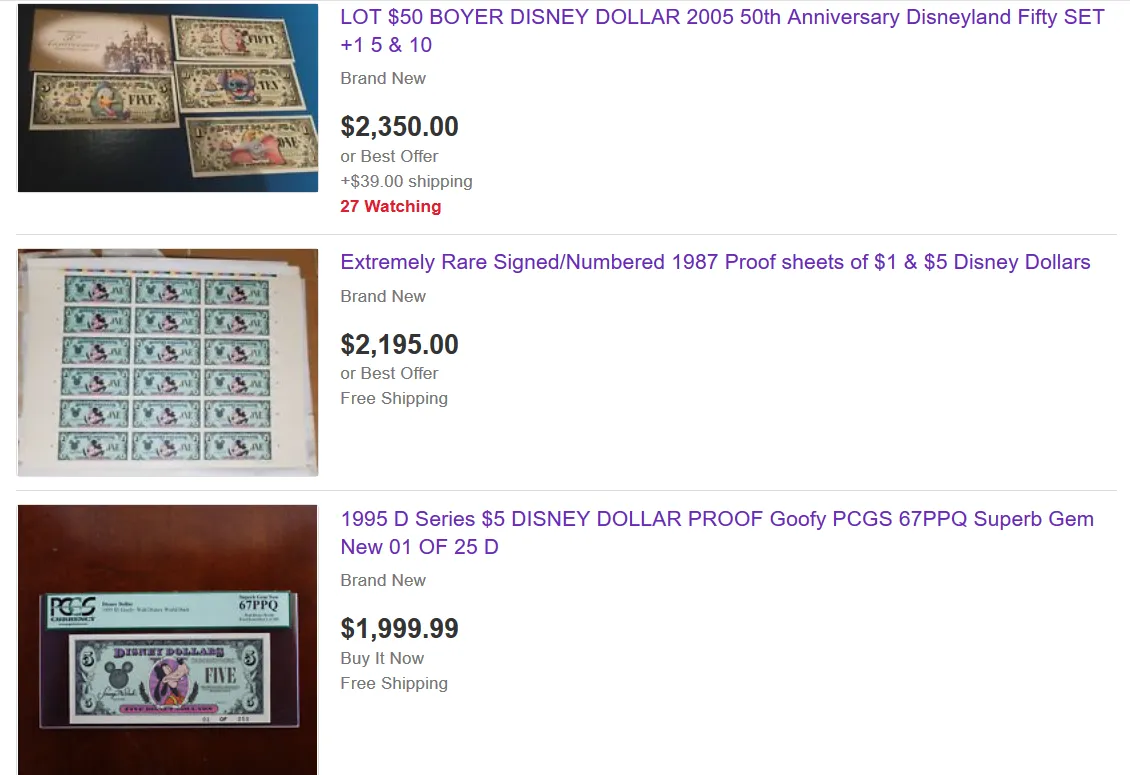
By browsing auctions for these, you’ll notice that the price is affected by the reliability and condition of the bill. The most reliable ones are graded by PCGS, PMG, or another reputable coin grading service. For example, PCGS stands for Professional Coin Grading Service and it is a coin grader that will also handle currency and some non-government issues, such as Disney Dollars. Graded coins sell for much more than plain bills, though do not be fooled by some of the selling prices, which are artificially high (wait until there is a bidder or buyer to evaluate the price).
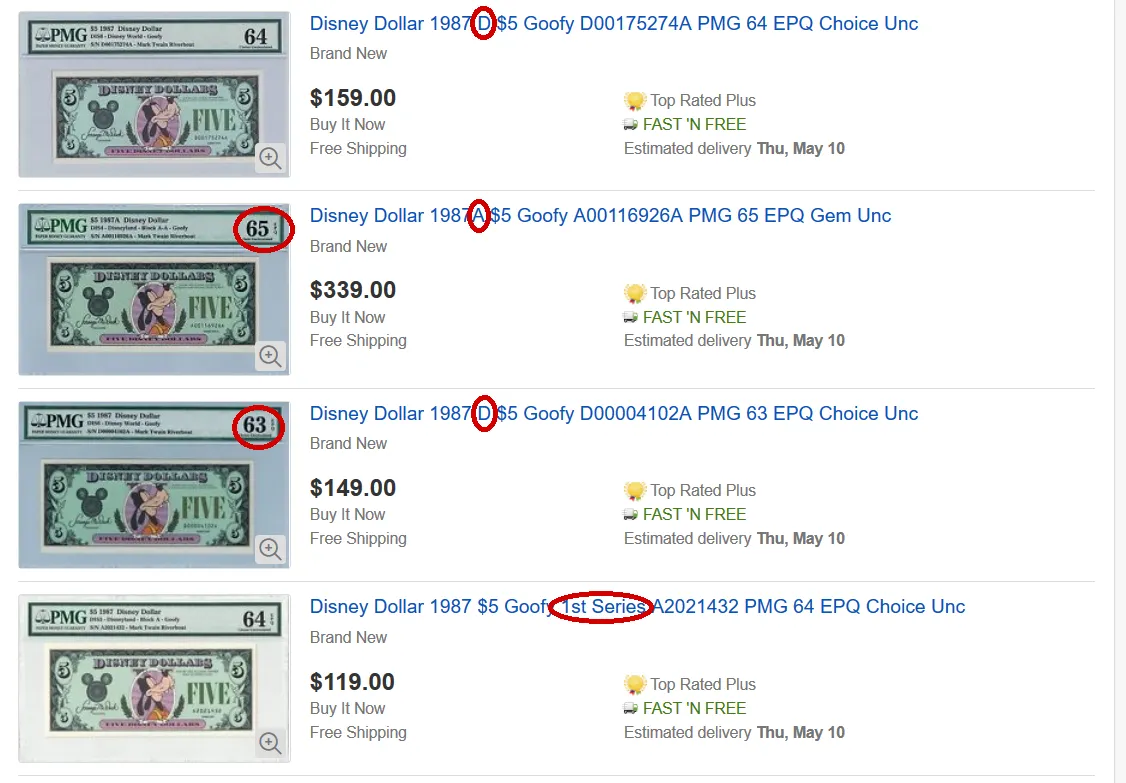
Source: ebay.com screenshot.
A grader examines and evaluates the condition of the item, sealing it in a protective semi-rigid plastic case and giving it a numbered grade to indicate its quality. A numbered PCGS grading in the high-60s or 70s is excellent, while a mid-60s grade still provides assurance to anyone buying the item that it is authentic and relatively pristine. In the 50s and low 60s, the grading serves only as reliability; the condition is lesser, so many buyers will not pay as much. If I’m buying as an investment, I’ll go down to 63 or 64, maybe 62 if it’s a deal, but I won’t bother buying anything lower because in the future, I won’t be able to sell it for a premium.
It All Began in 1987
Let’s look at where it began, which was 1987. If a collector’s item is worth owning, then people generally will bid highest for the earliest examples of it. This is true of sports cards, for example, where the most valuable card is from the player’s first (rookie) year. It’s also true with Disney Dollars, since the 1987’s sell well.
In 1987, Disney issued the $1 Mickey and the $5 Goofy. For each one, there were three series. The earliest series, dating to May 1987, is called Series A because the serial numbers began with “A”. The Mickeys began with “A1” and the Goofy bills with “A2”. They were designed to be used at both Disneyland and Disney World, but the “A” series was (mistakenly) printed with the words “May be used as legal tender only at Disneyland” (the words were all capitalized).

1987 Mickey dollar, one of the first issued. Courtesy of Disney.
Next, in September and October 1987, Disney printed two more sets and used the serial numbers to differentiate them. The “AA” series was distributed only at Disneyland, while the “DA” series was distributed at Disney World. The “AA” bills had serial numbers that began and ended with A’s, while the “DA” bills began with a D and ended with an A. Both had the same language this time, “May be used as legal tender only at Disneyland and Walt Disney World”. Again, these letters were all capitalized and in this version, an ® was added (meaning ‘registered trademark’) after each park’s name.
Buying Disney Dollars from 1987, especially that series “A”, makes a lot of sense. Remember, those are the ones printed with only “Disneyland” in the text. The PCGS-graded ones are overpriced already. You still can buy individual bills in good condition from sellers. Look for “mint” or “uncirculated” in quality. If you receive them in mint condition, you can send them into PCGS yourself to be graded; if the bill comes out with a mid-60s grade or above, then I can almost guarantee your investment has increased in value already.
Factors Affecting High Prices
So now, we’ve covered some extremely scarce Disney Dollars and the earliest ones. Looking at the other high-priced years/versions, we can conclude there are probably two main factors affecting their high prices. Either they are somewhat scarce (there’s that word again) or they are from anniversary years. As for whether Cinderella sells better than Stitch because people like Cinderella better than Stitch, those preferences may have some impact on the market, but it’s minor (watch me contradict myself below when we get to the Minnie part below, though).

These are from an anniversary year set. The bills shown at auction have matching serial numbers. Source: screenshot from ebay.com.
Also, there are many sellers who advertise certain serial numbers, such as low serial numbers (from early in the printing run) or consecutive or matched serial numbers. Consecutives are a set of bills with consecutive numbers (…1, …2, …3, etc.) , while matched bills come from different versions (for example, the princess set or the pirate set with each separate bill having the same serial number: imagine owning a Cinderella and an Aurora with exactly the same number on each). Of these, very low serial numbers may have additional value in the current market, but the other serial number tricks usually come from years that are not that valuable in their own right. Interesting serial numbers themselves are not enough to add value where there isn’t any yet, but when someone is shopping for a bill they like, they might pay more for an early or unusual serial number.
So let’s get back to two factors which DO seem to make a big difference to collectors: which bills are scarce and which important ones come from anniversary years? We’ll cover anniversary years first.
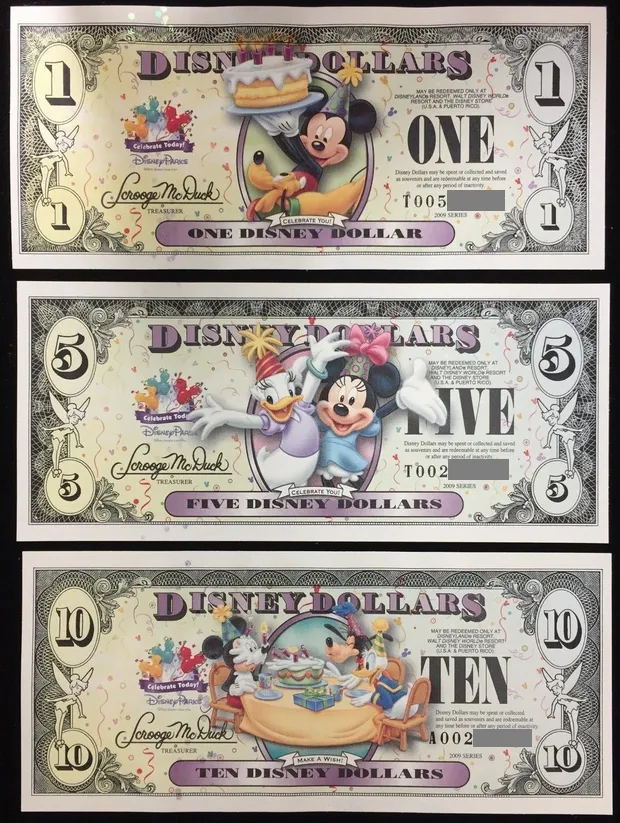
An anniversary issue. Source: screenshot from ebay.com.
Anniversary Years
There were a lot of Disney Dollars produced over a period of time; aside from the designs and pictures, how does a collector know which ones are most valuable? Just look at the market prices for anniversary year issues and you’ll notice that some of them go for higher prices than most other years. At the same time, many of them remain fairly cheap and these could be good choices for the future.
1993: Mickey’s 65th birthday. Prices are still low on these. They have not gone as high yet as other anniversary choices like the 2005’s, for example, but a healthy number of the 1993 auctions have some bids or show recent sales. If collectors/investors continue to focus on anniversary bills, more money may move into 1993s. These are affordable now and they could be a solid bet to appreciate nicely in the future.
1997: 25 year anniversary of Walt Disney World. They made three different designs: Sorcerer Mickey, Goofy, and Simba. The Sorcerer Mickey ones sell quite well and if you can find a deal on one, it should make a good investment. I have not seen Simba do well here yet and Goofy may be somewhere in the middle. If you want to speculate that the market will come around to these, the 1997 Goofy and Simba designs may be worth trying.
2002: 100 years of magic (presumably celebrating the birth date of Walt Disney in late 1901). The Tinkerbelle design seems popular here to the point of being expensive. Note: Some sellers write it as “Tinkerbelle” and others as “Tinkerbell”. Ebay’s algorithm does not correct this mistake, so look for both spellings to see if you can find any deals. Steemboat Willie and Snow White were the other designs that year.
2005: 50 year anniversary of Disneyland. The famous Boyer mirror design (see above) came out this year. Aside from the first year, 2005 was perhaps the most exciting set of issues. There were a lot of designs made for this anniversary. Some of them have seen a lot of collector/investor action already, while others remain less affected so far.
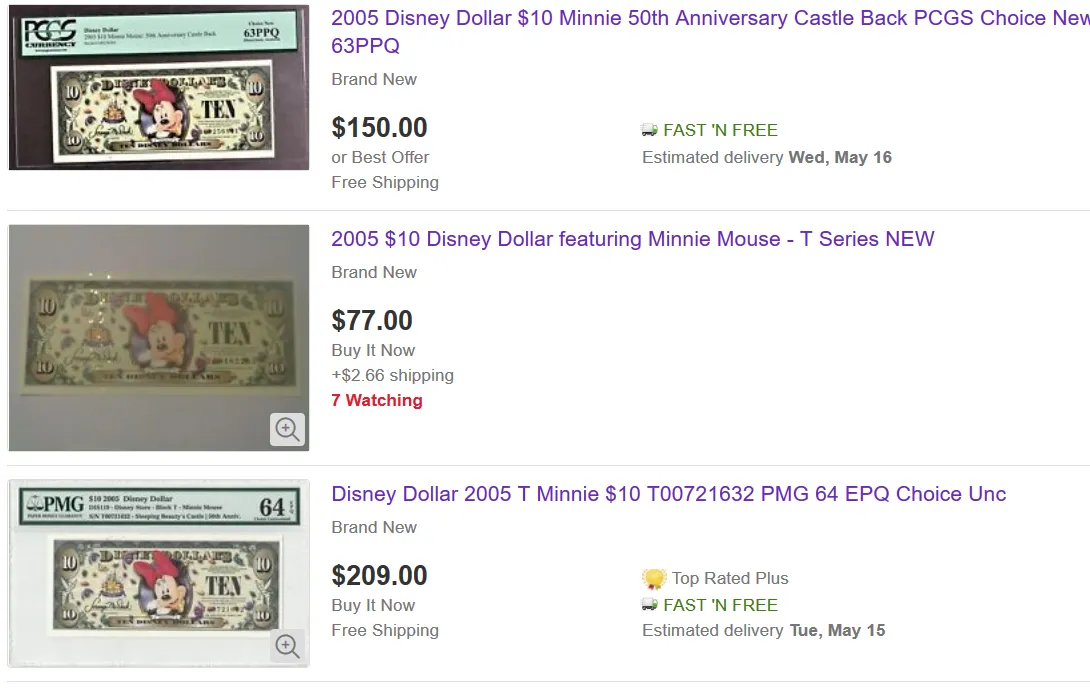
Source: Screenshot from ebay.com.
The Mickeyhead is popular. There’s a Cinderella and a Minnie that sell well. The Donald and the Goofy are solid. 2005 also included Dumbo, Chicken Little, and Stitch issues, which are not as popular, but could be good choices to appreciate in value.
2007: 20 years of Disney Dollars. This was not a major anniversary, but there were two themed sets that came out, which may be worth collecting in their own right. For more on these, see next section.
2008: Mickey’s 80th birthday. I haven’t seen much buying action yet on these. I’m guessing Disney printed a lot of them. It’s a late model in Disneydollarland, but the 2008’s could appreciate over time. This might be a year where you could consider buying a pack of bills if the per-unit price is significantly cheaper than buying them singly. Buy a bunch at decent value, sit tight, and wait for a few years to see what comes. They should go higher, at which time you can decide if they’re still more valuable as packs or sold individually.
Issues with Potential Value (from Anecdotal Observation)
1.) Anything with Minnie. Mickey may have been the original mouse and you could solidly focus on collecting many of the Mickey designs through the years (they are probably the highest value designs overall). But if I had to focus on one other character, particularly for scarcity, it would be Minnie. How can I say “scarce” when Minnie designs must have been issued in at least seven or eight different years?
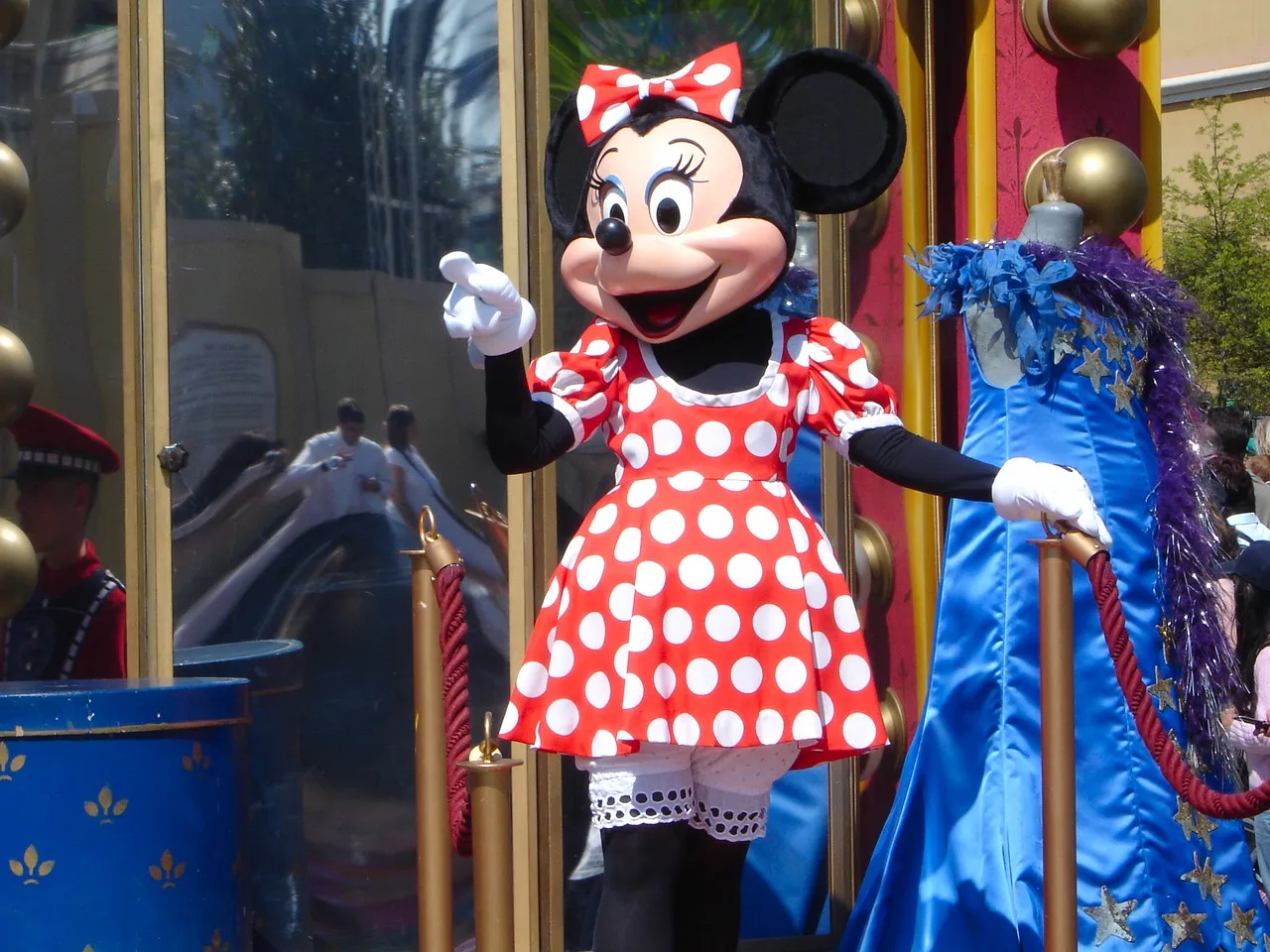
Minnie Mouse. Public domain.
Just look at what’s for sale and you see surprisingly few Minnies, probably fewer than there should be, given all those issues. Either they didn’t produce that many Minnies or people bought them and redeemed a lot of what they bought. Whatever the reason, the price of Minnies stays relatively high. Start anywhere; the earlier years like 1993 and 1998 are high already. There were some great combo designs in 2001 (vacation with Minnie + Mickey) and 2009 (Minnie + Daisy Duck); I would not hesitate to pay a reasonable price for any of those, expecting them to go up as the earlier Minnies have.
2.) Princess, Pirate, or Villain Themed Sets. I know, I know. They’re not scarce at all, but that makes them cheap. Disney clearly printed a junkload of the ‘Pirates of the Caribbean’ bills in 2007, for instance. Just look at all of the sellers trying to unload them with few takers. But those 2007 pirate issues came in a set of three. Over time, people will be selling them mostly as single bills. Would it be worth something to keep all three in the set of the Black Pearl, Empress, and Flying Dutchman? Those ships are on the reverse side with the pirate skull design on the front. 2007 also featured a set of three princesses: Cinderella, Aurora, and Ariel (throw in 2002 Snow White if you need another). There was another pirate bill in 2011. In 2013, there was a large villains set: Hook, Maleficent’s Dragon, Ursula, and Cruella. And there were other themes as well, but those should be popular in time (it may take a long time).
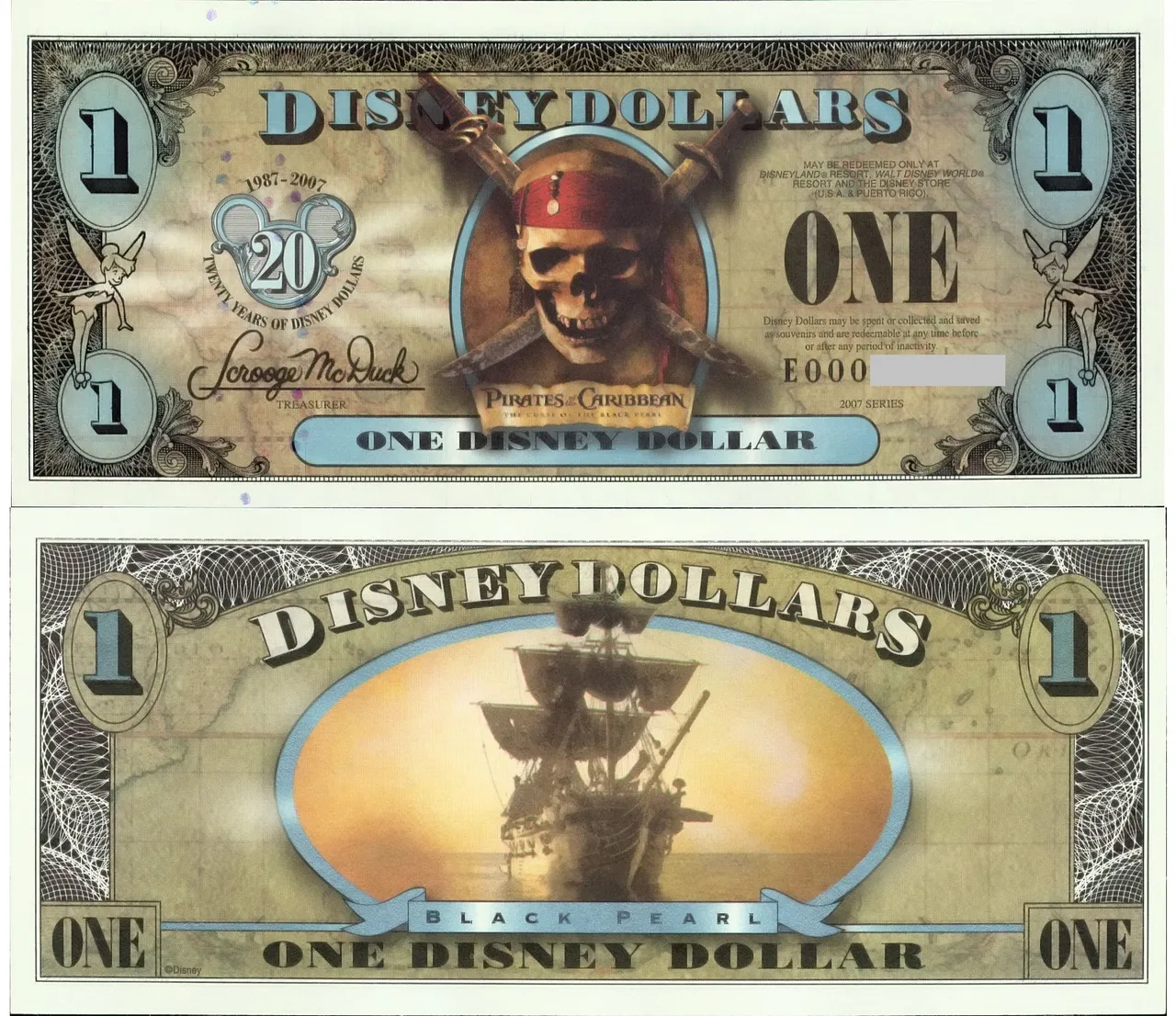
A dollar from the pirates theme. Source: willcad.org.
3.) 2009 Bills. There were three great designs this year in a celebration theme. I’m not sure what they were celebrating; it says “Celebrate you!” which is a good enough reason to party. These ones sit somewhere between an anniversary and a themed set, though they could be classified as either. These are attractive designs with multiple characters in pairs and ensemble, yet they can be had for an affordable price. I think they’ll yield a lot more in a few years, but these are late models, so be patient.
4.) Errors. Sooner or later, as coins get more valuable, collectors love error versions, since they are unusual and seem rare. Some 1990 Mickeys and 2011 pirates have an offset error, but it’s not major. One could argue that the very first 1987 A-series run of Mickeys and Goofy’s was in error because it only listed Disneyland, forgetting that second park in Florida.
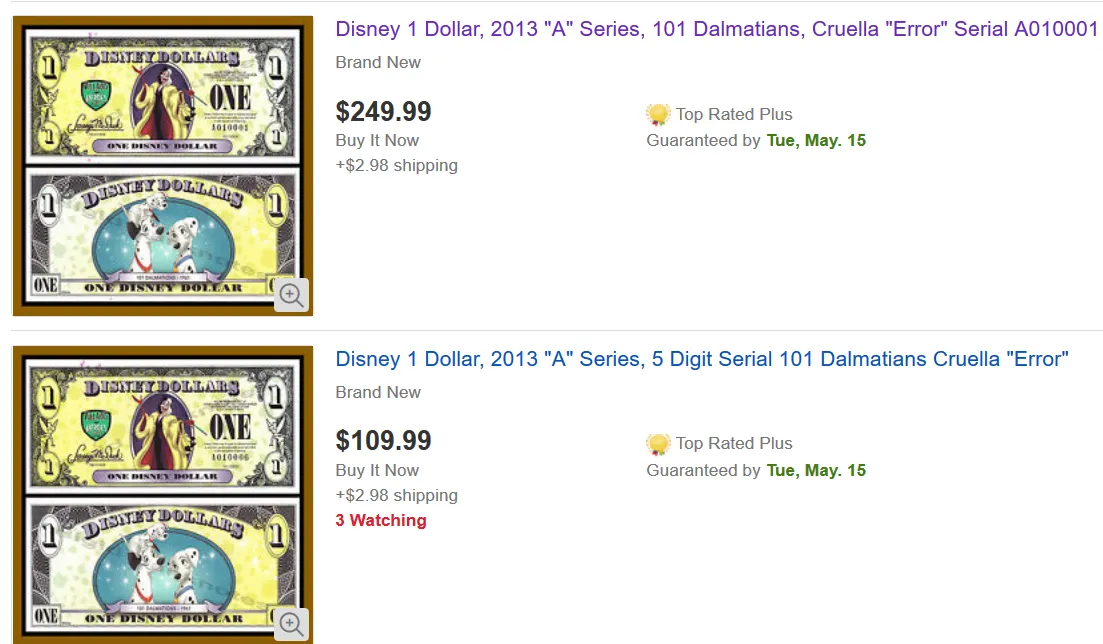
Cruella auctions emphasize the error. Note that the "Buy it Now" item is probably overpriced with the market value closer to the one that has actual bids. Source: ebay.com screenshot.
But coin graders only recognize one Disney Dollar issue for a major error. It’s the Cruella bill from the 2013 villain set. The Cruella issue misspelled her movie as “101 Dalmations” instead of the correct “101 Dalmatians”. Cruellas are already overpriced, but they’ll go a lot higher if I’m correct.
5.) Less popular characters in anniversary years. As I mentioned above, 2005 was a big year as an anniversary and a year that features some very high priced designs. But it also has others like Stitch, Dumbo, and Chicken Little, which have lower demand. Are they good value investments now? I thought so when the other 2005’s got into crazy territory with high prices, which is why I’ve cornered the market on the Dumbos: I own packs and packs of them. Will 2005’s rising tide also raise my flotilla of Dumbo bills and let me raft away into the sunset (or will people call me dumb-o)? Will other stray cats, like Simba in 1997, follow suit? Time will tell.
6.) Bulk quantities of late year bills. The early year Disney Dollars, the scarce ones, and the anniversary editions started increasing in value first, which is understandable. But you still can buy 25, 50, or 100-packs of later year dollars for much, much less. For some years, you can get a whole pack for nearly the same price as a single PCGS-graded bill. Don’t believe me? Check this out.
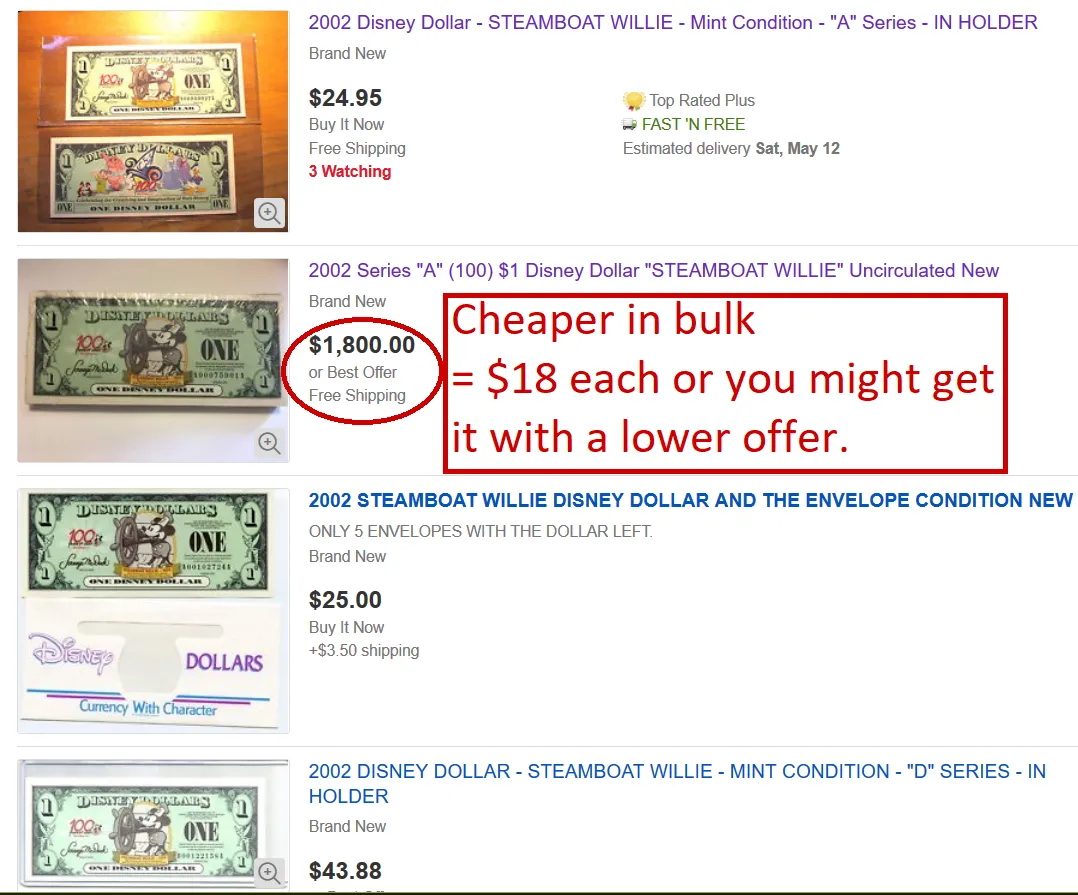
Often cheaper by the pack, but people may buy the singles when you're ready to sell. Source: screenshot from ebay.com.
In time, most or all of them should go up (which is my opinion only - please do your own research). And they’re all beautiful designs. Disney has never made a bad dollar.
Additional resources:
https://disneyworld.disney.go.com/faq/parks/using-disney-dollars/
https://www.kathsdisneydollars.com/store/c1/Featured_Products.html
http://www.disneydollars.net/